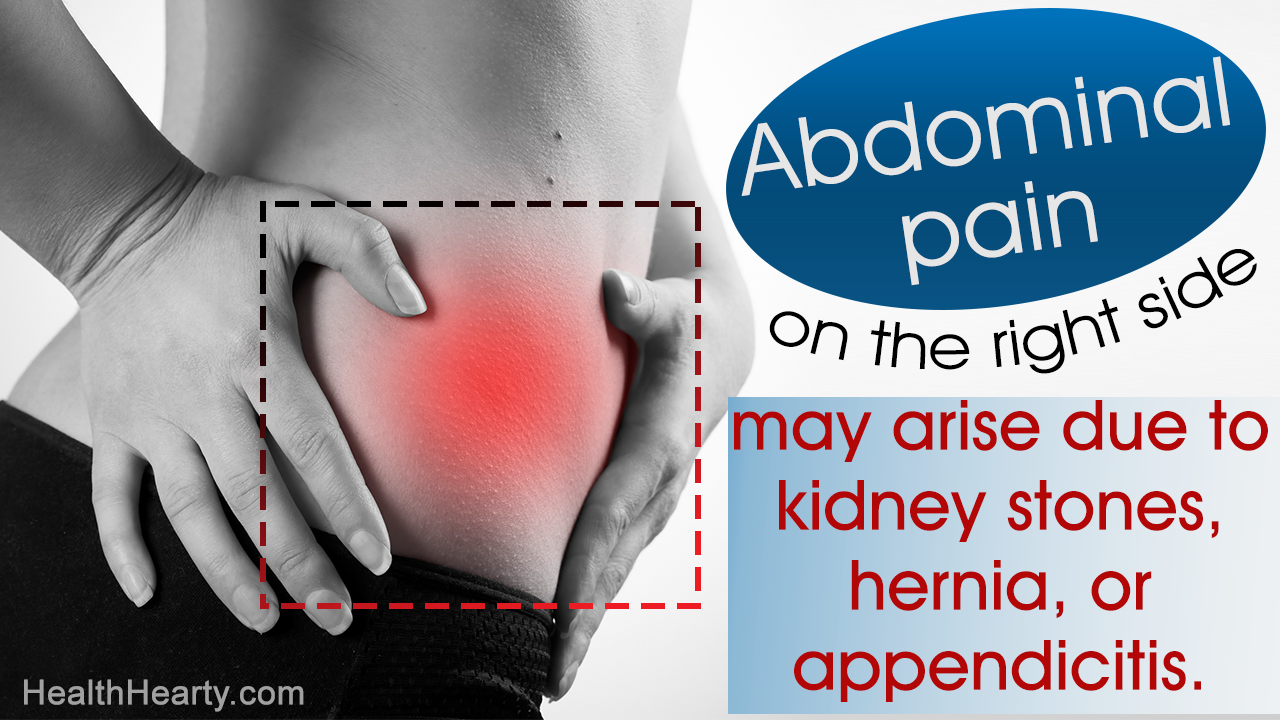
Appendicitis, kidney stones, hernia, gallstones, cholecystitis, etc., are some of the contributing factors for abdominal pain on the right side. This HealthHearty write-up lists out the conditions that might cause pain to the right of the navel.
The largest body cavity in the human body, the abdominal cavity lies between the chest and the pelvis. It is referred to as the space bounded by the abdominal walls, diaphragm, and pelvis. It contains various vital internal organs such as the stomach, liver, spleen, kidneys, gallbladder, pancreas, small bowel, and the colon.
If any of these organs are damaged due to an injury or a medical condition, the affected individual is likely to experience abdominal pain. The intensity of the pain would vary, depending on the extent of the damage. If the affected organ is placed on the right side of the abdomen, it would give rise to right-sided abdominal pain.
The following sections list the possible causes of pain on the right side of the navel.
Contributing Factors
As mentioned earlier, pain could arise from any of the organs present on the right side of the body, which include:
- Liver
- Gallbladder
- Pancreas
- Right kidney
- Appendix
- Abdominal muscles on the right side.
Medical conditions related to the aforementioned organs are discussed as following
Appendicitis
Appendix is a finger-like vestigial process that extends from cecum, which is a part of the large intestine. The term ‘appendicitis’ refers to the inflammation of the appendix. One of the characteristic symptoms of this condition is that the pain starts either in the upper abdomen or around belly button, and radiates to the lower right side of the abdomen.
Other symptoms that might accompany this condition include fever, nausea, and vomiting. If left untreated, the inflamed appendix could rupture, thereby causing the contents to enter into the abdominal cavity. The removal of the appendix is the suggested treatment option for this condition.
Kidney Stones
Also called renal calculi, kidney stones are hardened, stone-like deposits that form due to the crystallization of minerals in the urine. These form in the kidneys or any part of the urinary tract. Problems arise when the kidney stone is large. Under such circumstances, excruciating pain would be experienced, as the stone is passing through the ureters.
These could cause back or flank pain, abdominal pain, pain in the groin or genital region, nausea, vomiting, frequent and painful urination, blood in the urine, etc. If the kidney stone is lodged in the right ureter, the pain would be experienced on the right side of the abdomen.
Mesenteric Lymphadenitis
Mesenteric lymphadenitis is characterized by the inflammation of the lymph nodes in the double layer of peritoneum that attaches to the posterior wall of the abdominal cavity. The symptoms of mesenteric lymphadenitis are very similar to that of appendicitis. It gives rise to tenderness of the abdomen, right-sided abdominal pain, fever, diarrhea, nausea, vomiting, and malaise. However, it is not as serious as appendicitis.
Cholelithiasis and Cholecystitis
Gallstones are small deposits that form in the gallbladder (a small sac located under the liver) or the bile duct due to the concentration of cholesterol or bilirubin in bile. While the liver produces bile, it is the gallbladder that concentrates and stores this digestive fluid. Whenever the concentration of cholesterol or bilirubin in bile is high, it could give rise to crystallization of bile into stone-like deposits called gallstones.
The presence of gallstones is medically referred to as cholelithiasis. Gallstones that are lodged in the bile duct, cystic duct, or the hepatic duct can obstruct the flow of bile. This could give rise to inflammation of the gallbladder (cholecystitis). Under such circumstances, the affected individual could experience tenderness in the abdomen, pain in the right upper quadrant of the abdomen, pain radiating to the right shoulder or back, nausea, vomiting, or fever.
Hernia
The term ‘abdominal hernia’ refers to the protrusion of the contents of the abdomen through a weak spot in the abdominal wall. At times, weak spots might develop in some individuals with chronic, severe cough. Lifting heavy weights or straining during bowel movements could also be contributing factors. Though the characteristic symptom of hernia is a bulge, it could also cause a feeling of heaviness in the abdomen.
At times, pain might be felt when the affected individual lifts a heavy object. In some cases, complications could arise when a part of the intestine becomes trapped in the hernia sac. This could give rise to pain, nausea, or vomiting. A medical emergency could arise if there’s no blood supply to this part of intestine.
Cancer
Cancer is a serious medical condition that is characterized by the development of a malignant growth due to abnormal and uncontrolled cell division. Pain in the right upper quadrant of the abdomen could be due to the development of malignant growth in the liver or the pancreas.
Besides pain in the abdomen, pancreatic cancer can also cause bloating, nausea, diarrhea, bowel-related problems, jaundice, pale-colored stool, weight loss, loss of appetite, fatigue, etc. Liver cancer is characterized by jaundice, abdominal pain, itching, abdominal swelling, etc.
Besides the aforementioned conditions, pancreatitis, liver disease, trauma or any disease affecting the organs or anatomical structures located in the abdominal cavity could cause pain in the abdomen. In case of pregnant women, pain could arise in the lower abdominal region, if the fertilized egg gets implanted in the Fallopian tube instead of the uterus. Since pain in the abdominal region could be caused due to several conditions, and some of these could be a cause of serious concern, medical assistance must be sought if the pain persists.
Disclaimer:This HealthHearty article is for informative purposes only, and should not be used as a replacement for expert medical advice.


